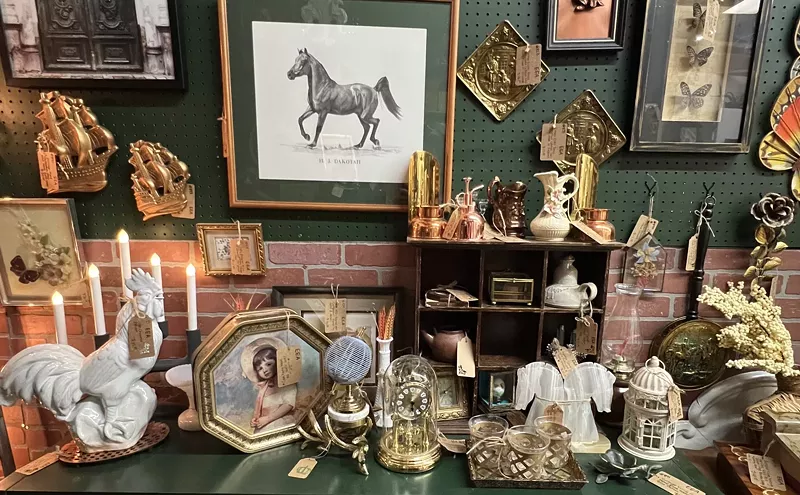First, unlike with other types of visual art including painting, sculpture, photography, architecture, whatever in order to see a video, you need equipment. If its a monitor, the typical and traditional accessory, the pieces are hemmed in by the box of the machine; if its a projection, a separate room must be cordoned off. Second, the audio that accompanies many pieces often overlaps, with the soundtrack from one work intruding while the viewer is taking in another. Third, theres the whole attention-span angle: a video has duration, and viewers have to spend a period of time watching it rather than being able to simply look at it for a moment or two, as they do an art object. Have you ever stared at a painting for eighteen, twenty minutes, an hour? I havent yet in video art, time is an inherent feature. And finally, in order to show the videos, the lights must be turned low, and some need total darkness. These necessities make the CVA seem cold and gloomy.
In my review of a dreadful, boring show at the Museum of Contemporary Art, I made a lot of people mad when I said Id never seen a video that was 10 percent as good as Lucy and Ethel at the chocolate factory; some accused me of being a philistine or even a reactionary dope. The fact is, however, that in a comparative analysis, everything may be judged against other things that are similar, and theres no reason that a video shouldnt be expected to stand up to television or to film (which is even worse for video). Ive seen epic-length movies and followed TV programs for a full season without being bored, yet for me with video, boredom typically sets in within a few minutes. So from my point of view, the best videos are those that you dont need to pay attention to as they play in the background, functioning something like animated wallpaper.
What Sound Does a Color Make? includes a historic section with pieces done in the 60s and 70s by the likes of the late Nam June Paik and Gary Hill. Oddly enough, these videos are conceptually indistinguishable from the newish works from the last year or two. That tells me that the medium is resistant to artistic development, despite the fact that major changes have transpired relevant to the medium itself, with video going from analog to digital. Do new paintings look different from old ones? How about TV shows? We all know they do so why do the old videos look just like the new ones, save for the dates displayed on the label copy? Oh, and the prices. Though these video pioneers were partly trying to get away from the object-ness of art, their limited-edition DVDs now sell for hundreds of thousands of dollars.
A favorite topic for video artists is static and the buzzing noises produced by it, or conceived to accompany it. In Scott Arfords installation in the entry space, Static Room, six monitors three on each side display screens of intermittent static. (These tube TVs look so old-fashioned in the age of flatscreens, which points up how technological advances make high-tech art look dated very quickly.) Though not technically static, the electronic trip down a tunnel of light in Light Turned Down, by Robin Rimbaud and D-Fuse, seems like Technicolor interference. Also using the more or less automatic features of video is Monochrome Transporter, by Thom Kubli, in which an LCD screen hung on the wall is lit up with a rich blue screen. This is one of the few genuinely beautiful works in the exhibit, but it does look exactly like my LCD TV when its warming up.
As I went through the show, a group of senior citizens from a nursing home was just finishing up a tour enthusiastically led by CVA director Jennifer Garner. Now, Ive been interested in contemporary art all my life, and this cacophony of an exhibit didnt mean much to me, so I had to wonder what it meant to those old-timers. As I said to Garner after they decamped to their bus, I hope that when Im their age, some do-gooder wont drag me off to see something as disconnected and irrelevant to my life as this exhibit.
Those retirees would probably find the three abstract-painting shows at + Gallery, where I wound up next, equally difficult. But this is where my lifetime interest in contemporary art served me well, because I thought these extremely compatible exhibits were absolutely marvelous. Director Ivar Zeile doesnt always come up with combinations that work this well, often preferring to go for some kind of aesthetic reach.
In the front space is an elegant solo, KAREN McCLANAHAN: Pitch Shift. McClanahan currently resides in Arizona, but she lived here briefly while attending the Rocky Mountain College of Art and Design, where she became a proteg of the great Clark Richert, who teaches painting at RMCAD. The masters influence is still apparent in her work, even though McClanahan went on to earn her MFA at New Yorks Hunter College this past May.
Although the paintings in Pitch Shift are distinct from her earlier work, they still have a lot in common with the older pieces. Both feature crisp margins between color fields, and both obliquely refer to architecture and the landscape. Most important, McClanahans work has always revealed a sublime taste in color. In the mismatched diptych Helios, she pairs a smallish square canvas with a larger horizontal one, with both having the same formal arrangements and the same color combination of a deep olive looking just right against a vibrant, almost vibrating red. The shows title refers to McClanahans intention to play with the figure/ground relationships in her compositions, so in places, a particular color field, line or bar is in the foreground, while elsewhere in the same painting it functions as the background. This break from the flatness of her earlier, hard-edged paintings is the key difference, but its a very subtle change, especially at first sight.
This move from flatly applied fields with hard edges between them to pieces in which veils of paint create softer edges is exactly the same progression highlighted in the solo DAVE YUST: CHROMAXIOLOGIC-INCLUSION SERIES, installed in the center space at +.
In the 60s and 70s, Yust did hard-edged minimalist paintings; as his work developed, he started laying on veils of paint and using softer color divisions. The show makes this progression clear, because in addition to fifteen works done just this year, theres a magnificent piece from 1974, Circular Composition #70. In this painting, Yust uses a four-foot-in-diameter roundel (he typically uses non-rectangular shapes) to arrange conventionalized, wave-like elements in green and blue that come in from the edge toward the center, which has been painted orange. A hidden armature underneath lifts up the canvas in places, making the paintings surface three-dimensional. This early painting bears a definite relationship to the newer ones, and it looks great with them.
The new works are from Yusts Chromaxiologic-Inclusion series. Yust coined the word chromaxiologic, first using it to describe these paintings and, in particular, the nature of color values and color value judgments. Yust has long been interested in color as much more than simply a palette; instead, its the very subject matter of these pictures. There are several standouts, including an enormous oval thats mostly a dusty purple, and a smaller, round one dominated by fiery red. Also engaging is the grid of nine monotypes, in which the picture planes are held within ovals surrounded by blank papers serving as frames.
Finally, in a niche beyond the Yust exhibit is CHRONICLES: New Paintings by Andrew Long. Though Long is also an abstractionist, his approach represents an aesthetic gear change from the sensibilities of McClanahan and Yust. Instead of echoing the elegant and smooth color fields those artists prefer, Longs paintings are organic and messy. He assembles a selection of clumsy organic shapes and renders them expressively by piling up thick layers of pigment for lots of painterly flourishes, or, alternately, by scraping it off in places while its still wet. Both techniques result in very rough surfaces. Longs palette is elaborate; based on a spontaneous free association, it features a variety of clashing tones like bubble-gum pink used against muddy brown. I especially liked the many tiny, eight-inch square paintings.
I wholeheartedly recommend this trio of excellent solos at + Gallery, particularly the one featuring Yust, since hes of supreme importance to the history of contemporary art around here. But the show closes in just over a week, so get a move on.











